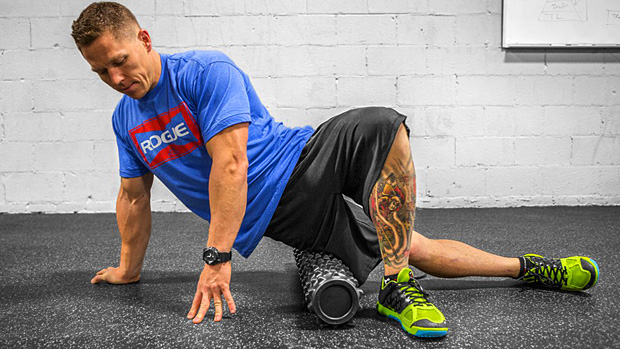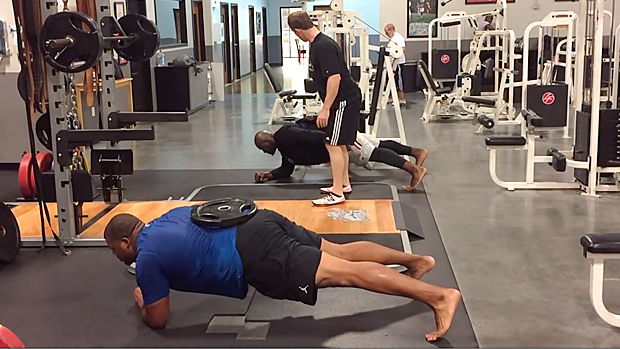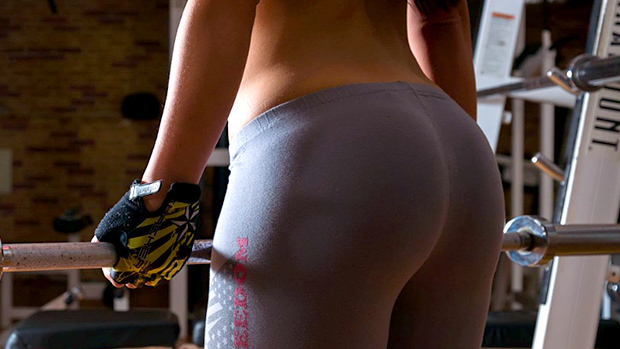Photo Credit: Rogue Fitness
Here's what you need to know...
- Fascia can undergo trauma over time. This results in the accumulation of fibrotic scar tissue, reducing the ability to build strength and grow muscle.
- Performing intense SMR work greatly increases the blood flow to and from the muscle. This translates to an increased pump, which facilitates growth.
- If your hamstrings are tight, it limits your mobility. SMR will increase your range of motion without causing you to lose strength, as traditional stretching would do.
- Adhesive tissue causes tightness along the muscle. By removing adhesive fascia from one muscle, you're increasing the activation of its antagonist.
- Extreme SMR work lessens the sensation of pain. After SMR, the muscle is free to contract without frictional hindrance.
- Proactive myofascial work is the key to preventing most injuries. A pulled muscle is almost always the result of the build up of unattended scar tissue.
You've got your training, nutrition, and sleep on point, but your job isn't done yet. There's a whole lot more you can do to maximize gains and it involves self-myofascial release (SMR) work. We're not talking about a few foam rolls on the IT band before you squat, though. We're talking about extreme SMR work. This is the type of work that separates the truly dedicated from those who are just messing around.
The fascia is a thin sheet of connective tissue that surrounds every organ and major tissue in the human body. It's made up of collagen that interlocks in a wavy pattern that allows it to be strong, yet flexible.
There are two main types of fascia, visceral and deep. Visceral fascia connects and suspends the internal organs of the body. Deep fascia is the connective tissue surrounding the muscular system. It wraps around every muscle and muscle fiber, separating them to reduce muscular friction. It also allows separation of the nerves, blood vessels, and capillaries that pass through them.
Fascia can undergo trauma over time, which will result in the accumulation of fibrotic scar tissue, making the connective tissue bind together. This makes it restrictive and inflexible and reduces the function of muscle in terms of flexibility, contractibility, and blood flow. In short, that can really hamper your gains.
Pick up one of those knobby black rollers (such as a RumbleRoller). This type of roller is much harder than a foam roller. Also, get a lacrosse ball. Other apparatuses are often just too soft and pale in comparison.
You can use these other devices to test just how bad off you are. If you can't fall asleep while lying on a tennis ball or regular foam roller because it causes you discomfort, then it should be an eye opener to how much work you really need to do.
1 Lacrosse ball on hamstrings.
The roller isn't precise enough to effectively work the hamstrings. Unlike other muscles where the individual heads are closer together, the hamstrings run farther apart along the femur. The lacrosse ball, however, can get in between each hamstring head that's missed by the roller.
Use the lacrosse ball on any hard chair. This allows you to accommodate flexibility while imposing the most bodyweight on one particular spot. The best ways to use the ball are:
- Running along the length of the muscle.
- Going perpendicular to the muscle. This works particularly well at the "glute-ham tie in" area.
- Holding the ball against a trigger spot while doing knee extensions and moving the leg in circular motions.
2 Roller on the front delt.
The front delt is both a shoulder flexor and an adductor and needs to be rolled out on both aspects. When rolling horizontally for adduction, you want to get deep toward the origin of the muscle, next to the clavicle and above the pec. There tends to be a lot of adhesion at that spot. You can add more weight by hiking your butt in the air.
3 Roller on the side deltoid.
Lie on your side on top of the roller and roll from the middle of the humerus to the top of the shoulder. There are seven deltoid heads. Three are reachable from this point, so changing your angle to slightly forward and slightly back will allow you to hit multiple heads. To increase tension and dig in further, flex your arm at about a 90-degree angle and place your hand under the elbow to "lift" it up as you move along the roller.
4 Roller on the pectorals.
Lie face down on top of the roller with your arm extended out and externally rotated. Roll from the sternum to the armpit insertions. You can angle yourself slightly to hit the clavicular head of the pecs. To hit the bottom portion of the pectorals, move your arm upward a few degrees and roll in a slightly diagonal path.
5 Roller on the biceps.
Use the same starting position as you did for the pecs, but move the biceps across the roller. You can stop at certain trigger points and rotate your arm perpendicularly to the muscle.
- Increased pump. Performing intense SMR work greatly increases the blood flow to and from the muscle. This translates to an increased pump, which facilitates growth. More blood flow means more nutrients being uploaded. It means increased healing and recovery.
- Increased flexibility. If your hamstrings are tight, it limits your mobility. SMR will increase your range of motion without causing you to lose strength, as traditional stretching might do.
- Increased activation of the targeted muscle. The removal of adhesions between muscle fibers means they're less locked in place. They become free to contract along with the other muscle fibers you're using. This also causes an increase in strength. You're now activating more fibers, thus creating more growth and strength gains.
- Increased muscle activation due to less neural muscular inhibition. Neuromuscular inhibition is the result of a muscle not firing the way it should due to the antagonist being too tight. Adhesive tissue will cause tightness along the muscle, even with full mobility. By removing adhesive fascia from one muscle, you're increasing the activation of its antagonist. You'll find that the activation and contraction of the muscle is much more pronounced after working on the antagonist. What you thought was "full" activation will pale in comparison. The antagonistic muscle will also have increased mobility without a loss in strength.
- Lessening the sensation of pain. Extreme SMR work lessens the sensation of pain when training a muscle. Imagine your muscle is a balloon placed in a glass bottle. When you train, the balloon expands and fills up with air but is now restricted by the bottle. Similarly, your muscle is trying to contract along that restriction, and that can be painful and uncomfortable. After SMR, the muscle is free to contract without frictional hindrance. This is one of the reasons people find leg training painful. After deep SMR on the legs, you may actually find it to be fun, with a pump akin to an arms workout. With this lessening of pain you can focus on working out harder, push for a new PR, and have more concentration during sticking points and increased performance on max-rep sets.
- Prevention of injury. Proactive myofascial work is the key to preventing most injuries. A pulled muscle is almost always the result of the build up of unattended scar tissue. The adhesive fascia that goes unattended over time sits and grows as a lifter continues to push through and it becomes a ticking time bomb.
It's probably hard for anybody to find time to do SMR on the entire body, so there are logical ways to break up the work:
- Classic bodybuilding split. The classic one body part a week split works well with this. Just practice SMR in the evening on whatever body part you're working the NEXT day. You get most of the main muscles done at least once a week and you won't worry if you missed anything.
- Spec training. A spec prioritizes one muscle group/pattern while maintaining everything else. So for a routine such as I, Bodybuilder where you train a specific body part three times a week, you focus all of your SMR time on that one body part.
- Use it on lagging muscles. A muscle group can lag for numerous reasons, among them having unfavorable leverages that use other muscles, poor activation, and having tons of restrictive fascia on said muscle. Let's say Bob has lagging triceps. Bob trains his tri's all the time, so he's developed a lot of tough fascia in and around the triceps. Bob no longer gets the same results as before, so he hammers them even harder, creating a cycle of fewer gains. What Bob needs to do is perform SMR on his triceps to allow them to grow.
- Off days. There's no such thing as off days, only days where you don't lift. If you can't work in an SMR session on your lifting days, then you can do it on your scheduled days off. These "off" days are now SMR days where you do work to make your next lifting days yield more fruit. Just remember not to skip any days. Once you start doing this regularly, any workouts done after missing an SMR session just won't feel right. The movements won't be as smooth and the pump won't be as intense. If you really want to verify the benefits of intense fascia work, perform SMR on a muscle on only one side of the body. Work out as normal. You'll immediately feel an awkward, imbalanced pump and lack of fluidity of movement.
- Multitask. You can do SMR work on a roller while watching TV. Use lacrosse ball on the hamstrings on a chair while using a computer. The point is to get it done.




